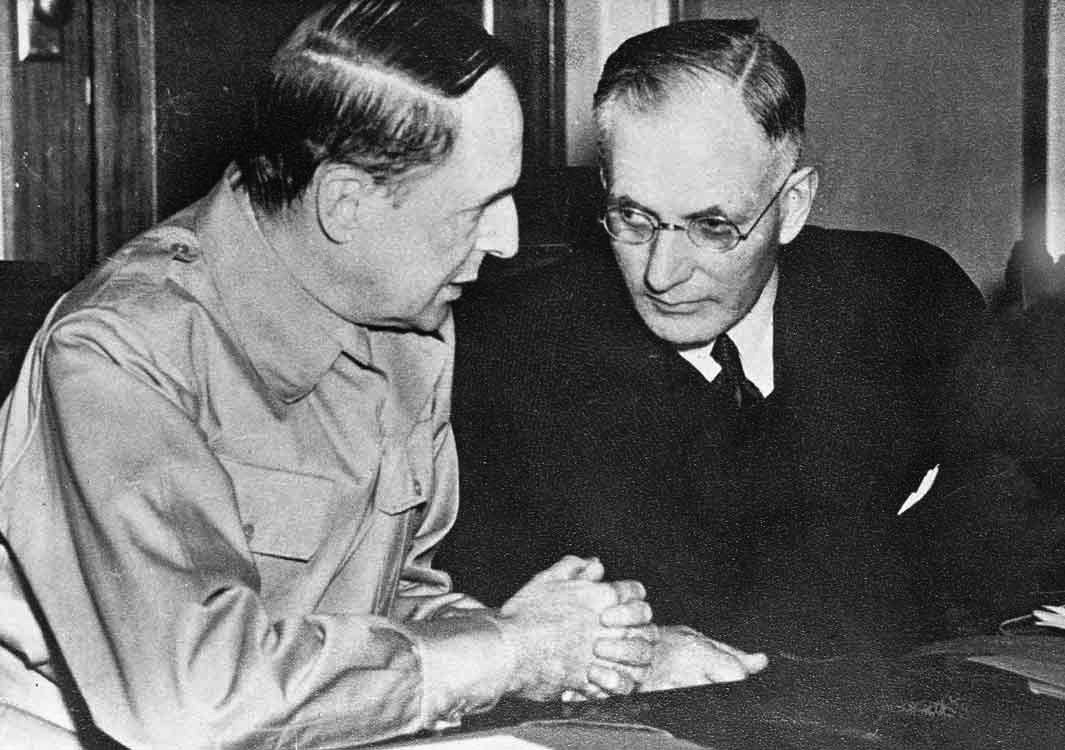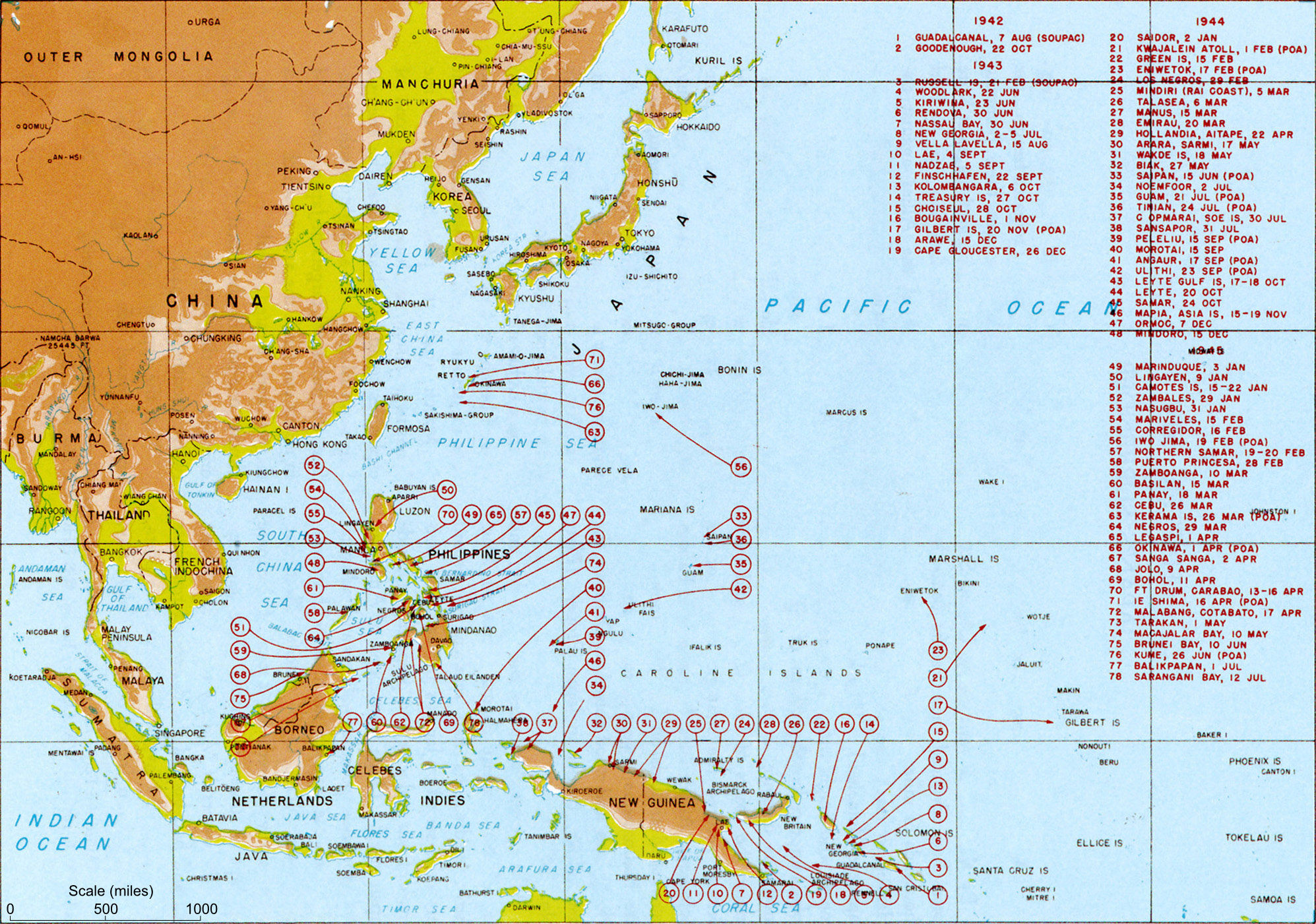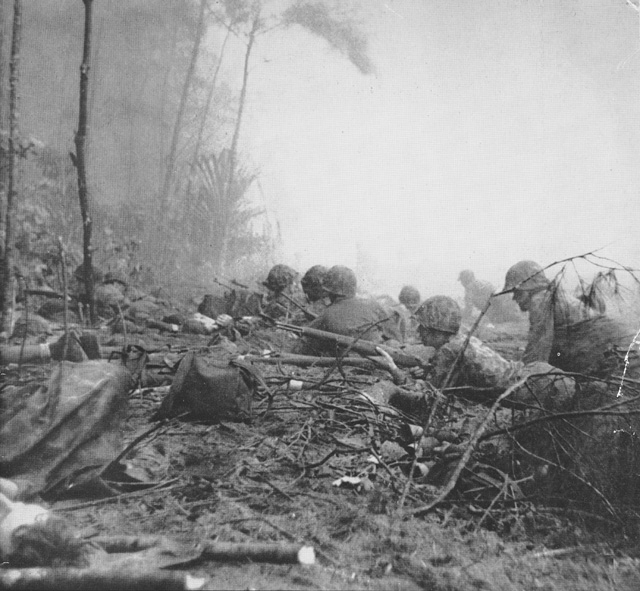|
Invasion Of Buka And Bougainville
Between 9 March and 5 April 1942 during World War II, forces of the Empire of Japan occupied the islands of Buka and Bougainville in the South Pacific. At that time Buka and Bougainville were part of the Australian-administered Territory of New Guinea. A platoon of Australian commandos from the 1st Independent Company was located at Buka Airfield when the Japanese landed but did not contest the invasion. The Japanese invaded in order to construct naval and air bases to provide security for their major base at Rabaul, New Britain and to support strategic operations in the Solomon Islands. After the occupation of Buka and Bougainville, the Japanese began constructing airfields across the island. The main airfields were on Buka Island, on the nearby Bonis Peninsula, and at Kahili and Kieta, while naval bases were also constructed at Buin in the south and on the nearby Shortland Islands. These bases allowed the Japanese to conduct operations in the southern Solomon Islands a ... [...More Info...] [...Related Items...] OR: [Wikipedia] [Google] [Baidu] |
Pacific War
The Pacific War, sometimes called the Asia–Pacific War or the Pacific Theatre, was the Theater (warfare), theatre of World War II fought between the Empire of Japan and the Allies of World War II, Allies in East Asia, East and Southeast Asia, the Pacific Ocean, Pacific and Indian Oceans, and Oceania. It was geographically the largest theatre of the war, including the Pacific Ocean theater of World War II, Pacific Ocean theatre, the South West Pacific theater of World War II, South West Pacific theatre, the Second Sino-Japanese War, and the brief Soviet–Japanese War, and included some of the Largest naval battle in history, largest naval battles in history. War between Japan and the Republic of China (1912–1949), Republic of China had begun in 1937, with hostilities dating back to Japanese invasion of Manchuria, Japan's invasion of Manchuria in 1931, but the Pacific War is more widely accepted to have started in 1941, when the United States and United Kingdom entered the ... [...More Info...] [...Related Items...] OR: [Wikipedia] [Google] [Baidu] |
South West Pacific Area (command)
South West Pacific Area (SWPA) was the name given to the Allied supreme military command in the South West Pacific Theatre of World War II. It was one of four major Allied commands in the Pacific War. SWPA included the Philippines, Borneo, the Dutch East Indies (excluding Sumatra), East Timor, Australia, the Territories of Papua and New Guinea, and the western part of the Solomon Islands. It primarily consisted of United States and Australian forces, although Dutch, Filipino, British, and other Allied forces also served in the SWPA. General Douglas MacArthur was appointed as the Supreme Commander, Southwest Pacific Area, on its creation on 18 April 1942. He created five subordinate commands: Allied Land Forces, Allied Air Forces, Allied Naval Forces, United States Army Forces in Australia (USAFIA), and the United States Army Forces in the Philippines. The last command disappeared when Corregidor surrendered on 6 May 1942, while USAFIA became the United States Army Serv ... [...More Info...] [...Related Items...] OR: [Wikipedia] [Google] [Baidu] |
Autonomous Region Of Bougainville
In developmental psychology and morality, moral, political, and bioethics, bioethical philosophy, autonomy is the capacity to make an informed, uncoerced decision. Autonomous organizations or institutions are independent or self-governing. Autonomy can also be defined from a human resources perspective, where it denotes a (relatively high) level of discretion granted to an employee in his or her work. In such cases, autonomy is known to generally increase job satisfaction. Self-actualization, Self-actualized individuals are thought to operate autonomously of external expectations. In a Medicine, medical context, respect for a patient's personal autonomy is considered one of many fundamental Medical ethics, ethical principles in medicine. Sociology In the sociology of knowledge, a controversy over the boundaries of autonomy inhibited analysis of any concept beyond relative autonomy, until a typology of autonomy was created and developed within science and technology studies. Acco ... [...More Info...] [...Related Items...] OR: [Wikipedia] [Google] [Baidu] |
South West Pacific Theatre Of World War II
The South West Pacific theatre, during World War II, was a major theatre of the war between the Allies and the Axis. It included the Philippines, the Dutch East Indies (except for Sumatra), Borneo, Australia, its mandate Territory of New Guinea (including the Bismarck Archipelago) and the Solomon Islands' western part. This area was defined by the Allied powers' South West Pacific Area (SWPA) command. Japanese forces fought primarily against the United States and Australian forces in the South West Pacific theatre. The Philippines, New Zealand, the Netherlands (in the Dutch East Indies), the United Kingdom, and other Allied nations also contributed forces. The South Pacific became a major theatre of the war following the Japanese attack on Pearl Harbor in December 1941. Initially, US war plans called for a counteroffensive across the Central Pacific, but this was disrupted by the loss of battleships at Pearl Harbor. During the First South Pacific Campaign, US forces sought ... [...More Info...] [...Related Items...] OR: [Wikipedia] [Google] [Baidu] |
1942 In Papua New Guinea
Year 194 ( CXCIV) was a common year starting on Tuesday of the Julian calendar. At the time, it was known as the Year of the Consulship of Septimius and Septimius (or, less frequently, year 947 ''Ab urbe condita''). The denomination 194 for this year has been used since the early medieval period, when the Anno Domini calendar era became the prevalent method in Europe for naming years. Events By place Roman Empire * Decimus Clodius Septimius Albinus Caesar became a Roman Consul. * Battle of Issus: Septimius Severus marches with his army (12 legions) to Cilicia, and defeats Pescennius Niger, Roman governor of Syria. Pescennius retreats to Antioch, and is executed by Severus' troops. * Septimius Severus besieges Byzantium (194–196); the city walls suffer extensive damage. Asia * Battle of Yan Province: Warlords Cao Cao and Lü Bu fight for control over Yan Province; the battle lasts for over 100 days. * First year of the ''Xingping'' era during the Han Dynasty in Ch ... [...More Info...] [...Related Items...] OR: [Wikipedia] [Google] [Baidu] |
Conflicts In 1942
Conflict may refer to: Social sciences * Conflict (process), the general pattern of groups dealing with disparate ideas * Conflict continuum from cooperation (low intensity), to contest, to higher intensity (violence and war) * Conflict of interest, involvement in multiple interests which could possibly corrupt the motivation or decision-making * Cultural conflict, a type of conflict that occurs when different cultural values and beliefs clash * Ethnic conflict, a conflict between two or more contending ethnic groups * Group conflict, conflict between groups * Intragroup conflict, conflict within groups * Organizational conflict, discord caused by opposition of needs, values, and interests between people working together * Role conflict, incompatible demands placed upon a person such that compliance with both would be difficult * Social conflict, the struggle for agency or power in something * Work–family conflict, incompatible demands between the work and family rol ... [...More Info...] [...Related Items...] OR: [Wikipedia] [Google] [Baidu] |
Battles And Operations Of World War II Involving Papua New Guinea
A battle is an occurrence of combat in warfare between opposing military units of any number or size. A war usually consists of multiple battles. In general, a battle is a military engagement that is well defined in duration, area, and force commitment. An engagement with only limited commitment between the forces and without decisive results is sometimes called a skirmish. The word "battle" can also be used infrequently to refer to an entire operational campaign, although this usage greatly diverges from its conventional or customary meaning. Generally, the word "battle" is used for such campaigns if referring to a protracted combat encounter in which either one or both of the combatants had the same methods, resources, and strategic objectives throughout the encounter. Some prominent examples of this would be the Battle of the Atlantic, Battle of Britain, and the Battle of France, all in World War II. Wars and military campaigns are guided by military strategy, whereas batt ... [...More Info...] [...Related Items...] OR: [Wikipedia] [Google] [Baidu] |
Surrender Of Japan
The surrender of the Empire of Japan in World War II was Hirohito surrender broadcast, announced by Emperor Hirohito on 15 August and formally Japanese Instrument of Surrender, signed on 2 September 1945, End of World War II in Asia, ending the war. By the end of July 1945, the Imperial Japanese Navy (IJN) was incapable of conducting major operations and an Operation Downfall, Allied invasion of Japan was imminent. Together with the United Kingdom and Republic of China (1912–49), China, the United States called for the unconditional surrender of Japan in the Potsdam Declaration on 26 July 1945—the alternative being "prompt and utter destruction". While publicly stating their intent to fight on to the bitter end, Japan's leaders (the Supreme War Council (Japan), Supreme Council for the Direction of the War, also known as the "Big Six") were privately making entreaties to the publicly neutral Soviet Union to mediate peace on terms more favorable to the Japanese. While mainta ... [...More Info...] [...Related Items...] OR: [Wikipedia] [Google] [Baidu] |
Australian Army Reserve
The Australian Army Reserve is a collective name given to the military reserve force, reserve units of the Australian Army. Since the Federation of Australia in 1901, the reserve military force has been known by many names, including the Citizens Forces, the Citizen Military Forces, the Militia and, unofficially, the Australian Military Forces. In 1980, however, the current name—Australian Army Reserve—was officially adopted, and it now consists of a number of components based around the level of commitment and training obligation that its members are required to meet. Overview For the first half of the 20th century, due to a widespread distrust of permanent military forces in Australia, the reserve military forces were the primary focus of Australian military planning.Grey 2008, pp. 66–83. Following the end of World War II, however, this focus gradually shifted due to the changing strategic environment, and the requirement for a higher readiness force available to support ... [...More Info...] [...Related Items...] OR: [Wikipedia] [Google] [Baidu] |
United States Army
The United States Army (USA) is the primary Land warfare, land service branch of the United States Department of Defense. It is designated as the Army of the United States in the United States Constitution.Article II, section 2, clause 1 of the United States Constitution (1789).See alsTitle 10, Subtitle B, Chapter 301, Section 3001 It operates under the authority, direction, and control of the United States Secretary of Defense, United States secretary of defense. It is one of the six armed forces and one of the eight uniformed services of the United States. The Army is the most senior branch in order of precedence amongst the armed services. It has its roots in the Continental Army, formed on 14 June 1775 to fight against the British for independence during the American Revolutionary War (1775–1783). After the Revolutionary War, the Congress of the Confederation created the United States Army on 3 June 1784 to replace the disbanded Continental Army.Library of CongressJournals ... [...More Info...] [...Related Items...] OR: [Wikipedia] [Google] [Baidu] |
Beachhead
A beachhead is a temporary line created when a military unit reaches a landing beach by sea and begins to defend the area as other reinforcements arrive. Once a large enough unit is assembled, the invading force can begin advancing inland. The term is sometimes used interchangeably (both correctly and incorrectly) with '' bridgehead'' and '' lodgement''. Beachheads have been important in many military actions; examples include operations such as '' Operation Neptune'' during World War II, the Korean War (especially at Inchon), and the Vietnam War. Although many references state that ''Operation Neptune'' refers to the naval operations in support of ''Operation Overlord'', the most reliable references make it clear that ''Overlord'' referred to the establishment of a large-scale '' lodgement'' in Normandy, and that ''Neptune'' referred to the landing phase which created the beachhead; ''Neptune'' was therefore the first part of ''Overlord''. According to the D-Day Museum: O ... [...More Info...] [...Related Items...] OR: [Wikipedia] [Google] [Baidu] |
Landings At Cape Torokina
The Landings at Cape Torokina (1–3 November 1943), also known as Operation Cherryblossom, took place at the beginning of the Bougainville campaign (1943-45), Bougainville campaign in World War II. The amphibious warfare, amphibious landings were carried out by elements of the United States Marine Corps in November 1943 on Bougainville Island in the South Pacific, as part of Allies of World War II, Allied efforts to advance towards the main Japanese base around Rabaul under Operation Cartwheel. Coming in the wake of Allied successes at Guadalcanal Campaign, Guadalcanal and in the central Solomon Islands campaign, Solomons, the landings were intended to secure a beachhead with the purpose of establishing several bases from which to project air and naval power closer towards Rabaul, in an effort to neutralize the large Japanese force that had been established there. In the months leading up to the operation, Japanese airpower on Bougainville was degraded by Allied air strikes, wh ... [...More Info...] [...Related Items...] OR: [Wikipedia] [Google] [Baidu] |





